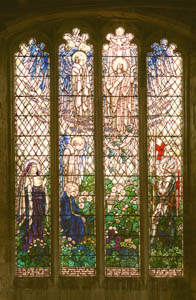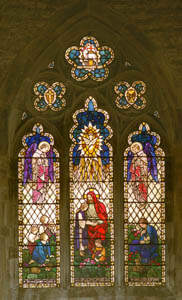Millennium Project
Elizabeth Tothill
These windows are at the east end of the north aisle of the Church of St Peter & St Paul, which is now the Lady Chapel and houses the Mothers' Union Banner. Dr Jones was a General Practitioner for many years in the early part of this century. He lived and had his practice at Ilbury House in New Street. He was twice married, first to Emily May whose memorial window is above the altar and who died without children in 1923, and secondly to Muriel, whose window is the most easterly on the north wall of the Lady Chapel. They had two children, Lesley and Martin. Muriel was the daughter of Mary Vane Turner who wrote The Story of Deddington, published in 1933 and quoted below. The book is dedicated to Muriel 'our first President [of the Women's Institute in Deddington]'. Both windows were designed by Archibald Davies of the Bromsgrove Guild, Worcestershire. Davies worked intermittently for the Arts and Crafts firm of Morris, Marshall, Faulkner and Co between 1909 and 1928, and the firm's influence is clearly seen in these windows.
The Emily May Jones Memorial Window
 The dedication at the base of the window reads: 'To the Glory of God and in Loving Memory of Emily May Jones. This window is placed by her husband in humble thankfulness for 26 years of happy union. She entered into Rest October 6th 1923. ... also in pious memory of her mother Emily Hannah Williams and her brother Henry Hugh Mckenzie Williams.
The dedication at the base of the window reads: 'To the Glory of God and in Loving Memory of Emily May Jones. This window is placed by her husband in humble thankfulness for 26 years of happy union. She entered into Rest October 6th 1923. ... also in pious memory of her mother Emily Hannah Williams and her brother Henry Hugh Mckenzie Williams.
"Oh Death where is thy sting
Oh Grave where is thy victory" '
In The Story of Deddington Mary Vane Turner writes: '... the beautiful stained glass window by A J Davies, executed by the Bromsgrove Guild, Worcestershire, depicting the Assumption of the Blessed Virgin, with on the lower panels the Annunciation and the figures of Hannah, mother of Samuel, and of Saint George either side, unveiled in June 1924, was to the memory of the first wife of Dr George Horatio Jones and of her mother and brother.'
Although the Assumption of the Blessed Virgin Mary is an unusual subject for an Anglican Church, its position behind the altar of the Lady Chapel and its dedication to a lady whose second name was May, make it an appropriate one. (May is an abbreviation of Mary). The window, which has a predominance of blue and green tinted glass, has an extraordinary feeling of tranquillity and prayerfulness. Davies, working within the Arts and Crafts tradition (which was strongly influenced by medieval and Renaissance art) uses the pre-Reformation idea of the picture frame (in this case the real stone window) as a window into heaven. The most noticeable feature is the 'paradise garden'. Many of the flowers are associated with Mary in religious art. It is possible, of course, that these were also Emily's favourite flowers. The lush greenery and profusion of flowers were the fashion in gardens of the time - and I am informed that the Jones family loved their garden. In the garden is a cracked tomb and above it the figure of Mary in her heavenly form looks up, hands raised towards the Dove of the Holy Spirit. Our eyes are drawn with hers upwards through the streams of heavenly radiance and out of the window frame.
In the centre-left panel Mary is seen sitting quietly in an attitude of prayer with an angel standing behind her. This is Mary at the time of the Annunciation and is Emily May's name-saint (see above). In the top half of the panel there are angels leading our eyes through the window and up to heaven. Between the angel of the Annunciation and the angels in heaven we can see broken shafts of light (or God's grace) coming through blue horizontal flame shapes. The latter could possibly be seen as representing the heavenly firmament of medieval paintings where heaven and earth were thought to be divided by crystal spheres - with holes to let comets, shooting stars etc through.
On either side of the two central panels are the name-saints of Emily May's mother and husband. On the left is Hannah (her mother's second name). Though not strictly a saint, she is much revered in the Old Testament as the mother of the prophet, Samuel, and it is on her song of praise and thanksgiving to God (1 Samuel, ch. 2 v. 1-11) that Mary's 'Magnificat' is based.
The right-hand window represents Dr Jones' name-saint, St George. He stands holding the red cross banner of the Resurrection, his eyes raised to the Mary of the Assumption. Mary Vane Turner's book informs us that Dr Jones served in the Royal Army Medical Corps between 1916 and 1918 both on hospital ships and in Egypt, so the figure of St George helps to establish the army connection. As Emily's brother, Henry Williams, is commemorated under the St George panel, it is possible (though I have no evidence) that he was a soldier, perhaps missing in action.
There is much to ponder in this glorious window which admirably fulfils its dedication to the 'Glory of God'.
The Muriel Vane Jones Memorial Window
 The dedication at the base of the window reads:
The dedication at the base of the window reads:
'To the Glory of God and in dear memory of Muriel Vane Jones. This window is placed by her husband, her mother, her son and her daughter. April 21 1936, aged 42.'
Although this window was designed by the same artist, A J Davies, as the earlier window commemorating the first Mrs Jones, his style has evolved so that it now has a strong 1930s feel to it. It is seen at its best during a summer Evensong when the brilliant jewel colours are illuminated by the setting sun, for it is the peace of evening and the simplicity of children's prayers that this window illustrates.
In the central panel of the window Jesus, dressed in a red robe, is seen sitting in a field of biblical flowers and grasses. An older girl in 'bible' dress leans her head on His shoulder, her hands in His. At His feet a toddler picks flowers, self absorbed but quite content in Jesus' presence. Above His head, against a background of the sapphire blue of an early night sky studded with stars, is the Dove of the Holy Spirit set in a golden 'mandorla' (an almond shaped aureole used in medieval art).
The left hand panel shows children of different ages in 1930 style dress. They are sitting in the same field of wild flowers and are accompanied by rabbits enjoying the cool of the evening. The background has streams of light (or, perhaps, blessings) and stars. All the children are looking at Jesus. Above their heads there is a Guardian Angel who looks like an illustration from a children's prayer book of the time. In the right hand panel there is a matching Guardian Angel above a mother and child who are sitting quietly on the grass. She is dressed in a blue robe and her attitude, sitting on the ground, recalls popular medieval paintings of the Virgin of Humility. She is accompanied by a mother and baby rabbit, daisies, single roses, poppies (especially prevalent around Deddington) and , interestingly, alchemilla mollis or Lady's Mantle. Like the Guardian Angels, she has a 1930s face and hairstyle, so could this be an idealised representation of Muriel herself?
The three panels are surmounted by tracery lights. These contain symbols of the Resurrection, the Cross and the Eucharist each within a mandorla and against the same background of early night sky as the Dove and the angels.
I think that this enchanting window illustrates the text 'Suffer little children to come unto me and forbid them not: for of such are the kingdom of God' (Luke, ch. 18 v. 16, King James Bible). José Stevens remembers her Sunday School teacher taking the children to see the window shortly after it was dedicated and telling them that it illustrated the famous children's prayer:
'Gentle Jesus, meek and mild
Look upon a little child.
Pity my simplicity
Suffer me to come to thee.'
It is this simple beauty as much as the glorious colours of this window which touch the heart.
Taken together, these windows have many contrasts as well as their obvious similarities. They can be taken to illustrate mankind's dual nature - body and soul, but perhaps also an essential dichotomy, characteristic of the Church, which reaches upwards to heaven and outwards to the child in us all.
Acknowledgements
This is the abbreviated text of an illustrated leaflet produced for the Restoration Appeal of the Church of St Peter & St Paul, Deddington, available from the church.Thanks are due to Helen Rose for use of her research on A J Davies.